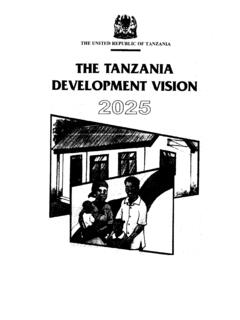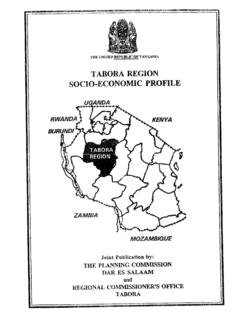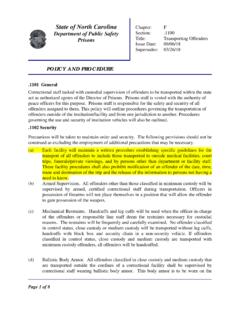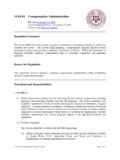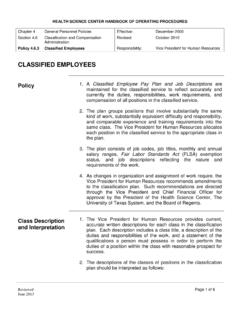Transcription of GOVERNMENT OF THE UNITED REPUBLIC OF TANZANIA
1 1 GOVERNMENT OF THE UNITED REPUBLIC OF TANZANIAGOVERNMENT OF THE UNITED REPUBLIC OF TANZANIA EDUCATION SECTOR DEVELOPMENT EDUCATION SECTOR DEVELOPMENT PROGRAMME PROGRAMME Primary Education Development Plan (2002-2006) Basic Education Development Committee (BEDC) July 2001 ii Table of Contents i ii iv EXECUTIVE v 1.
2 1 2. POLICY 2 TANZANIAN COMMITMENTS TO INTERNATIONAL EDUCATION 2 EDUCATION AND TRAINING POLICY .. 2 EDUCATION SECTOR DEVELOPMENT PROGRAMME .. 2 TANZANIA DEVELOPMENT VISION 3 POVERTY REDUCTION STRATEGY 3 LOCAL GOVERNMENT REFORM 4 3. DEVELOPMENT PLAN 4 ENROLMENT 4 Enrolment and 5 Teacher Recruitment and 6 7 Out-of-School Children and 8 QUALITY 9 Human 9 Teaching and Learning 10 CAPACITY 11 Pre-Service Teacher 11 Management 12 Financial 13 Educational Management Information 14 PEDP INSTITUTIONAL 14 Administrative 15 Institutional 15
3 Village/Mtaa 15 Ward 16 District 17 Regional Ministry of Education and 18 President s Office-Regional Administration and Local 19 Basic Education Development ESDP Steering Committee ..20 Donors and Funding 21 NGOs and Civil 22 4. 22 ANNEXES 1. Primary Education Recurrent Budget Unit 24 iii2.
4 PEDP Cost 26 3. PEDP 27 4. Primary School Enrolment .. 28 5. Teacher and Classroom 29 6. Primary School Unit 30 7. Out-of-School Children and Youth Projections and Programme 31 8. ESDP Institutional Framework for PEDP 32 ivLIST OF ABBREVIATIONS BEDC Basic Education Development Committee CB Capacity Building CG Capitation Grant DED District Executive Director EFA Education for All EMIS Education Management Information System EPF Education Programme Fund ESDP Education Sector
5 Development Programme ETP Education and Training Policy GDP Gross Domestic Product GER Gross Enrolment Rate D/S Double Shift HIPC Highly Indebted Poor Countries HT Head Teacher IAE Institute of Adult Education IEC Information, Education and Communication IFMS Integrated Financial Management System IG Investment Grant INSET In-Service Teacher Training LGAs Local GOVERNMENT Authorities LGRP Local GOVERNMENT Reform Programme M&E Monitoring and Evaluation NECTA National Examination Council of TANZANIA NFE Non-Formal Education NGO Non-governmental Organisation MANTEP Management Training of Education Personnel
6 MOEC Ministry of Education and Culture MoF Ministry of Finance MTEF Medium-Term Expenditure Framework PTR Pupil-to-Teacher Ratio PEDP Primary Education Development Plan PER Public Expenditure Review PO-RALG President s Office Regional Administration and Local GOVERNMENT PRSP Poverty Reduction Strategy Paper PSRP Public Service Reform Programme RAS Regional Administrative Secretary RS Regional Secretariat TIE TANZANIA Institute of Education TLS TANZANIA Library Services UPE Universal Primary Education USD UNITED States Dollar UDSM University of Dar-es-Salaam WEC Ward Education Co-ordinator vEXECUTIVE SUMMARY TANZANIA is party to many international conventions and agreements regarding
7 Improving the access, equity and quality of education. Since 1995, the GOVERNMENT has initiated a series of policies and reforms in the education sector with the aim of ensuring that ALL children have equitable access to a good quality primary education. No child should be denied the opportunity to participate in education because of poverty, gender, disability, or because of a lack of school uniform, fees or other parental contributions, or because of a lack of school facilities, materials or teachers.
8 The Primary Education Development Plan (PEDP) is a five year plan that articulates this vision of Universal Primary Education within the wider Tanzanian policy frameworks of the Education and Training Policy and the Education Sector Development Programme, the Local GOVERNMENT Reform Programme, and the over-arching Poverty Reduction Strategy Paper and Vision 2025. The PEDP consists of four main components: (a) expanding enrolment; (b) improving the quality of teaching and learning processes; (c) building capacity within the education system and other public and private sectors with a stake in education provision; and (d) strengthening the institutional arrangements that support the planning and delivery of education services.
9 In order to achieve the objective of enrolling all children 7-10 years old by 2005, the PEDP focuses on issues of enrolment and access, teacher recruitment and deployment, and classroom rehabilitation and construction. It also includes interim plans for expanding non-formal educational programmes for out-of-school children and youth. The objective of improving educational quality will be met by strengthening three areas. In Human Resources, the primary focus is on the in-service professional development of the teacher, with complementary efforts focussed on head teachers, school committees, and training college tutors.
10 With regards to Teaching and Learning Resources, the emphasis is on textbooks and materials, the quality and relevance of the curriculum, and the school environment. In addition to the input of training and materials outlined above, the quality of education is dependent on the capacities of the people and the systems. Therefore the capacity building objective concentrates efforts on establishing an awareness and familiarity with governance and management principles amongst all education stakeholders, especially school committees and communities.

